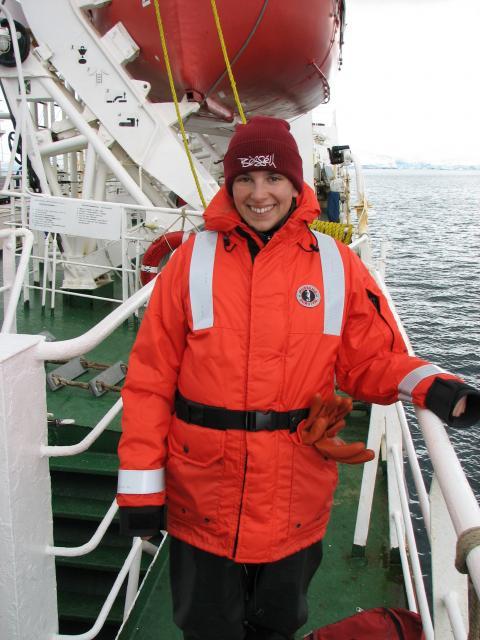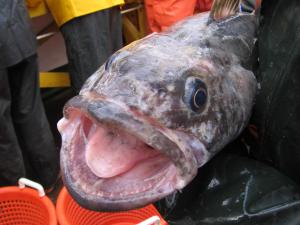
Studying Antarctic toothfish and the special proteins in their bodies that help them thrive in subfreezing waters
Cassandra Brooks is a marine scientist and science writer based in California. She’s studied Antarctic marine resources since 2004 at Moss Landing Marine Laboratories (MLML) and with the Antarctic Marine Living Resources (AMLR) Program.
Cassandra Brooks first began studying Antarctic toothfish in 2004 as part of her master’s thesis at Moss Landing Marine Laboratories. Antarctic toothfish are large, deep-sea predatory fish found only in the ice-laden waters surrounding Antarctica. Biologists who were fascinated with their ability to live in these freezing waters were the first to study these fish. It turns out that Antarctic toothfish have special proteins in their bodies that act like anti-freeze to keep their blood from freezing, thus enabling the fish to live in the icy waters off Antarctica.
Commercial fishermen took notice of the Antarctic toothfish only in the last ten years when populations of its sister species, the Patagonian toothfish, became depleted. Patagonian toothfish are found in the northern waters of the Southern Ocean, off the tip of South America and around sub-Antarctic islands. Both species of toothfish are more commonly known by their market name “Chilean Sea Bass,” though they bear no relation to sea bass. The depletions of Patagonian toothfish were likely caused by the large illegal pirate fishery, which has been estimated at up to 70 percent of the total harvest of this species.
As the subantarctic waters where the Patagonian toothfish lives were overharvested, vessels moved further south, into the remote and pristine waters of the Ross Sea, Antarctica, in search of the Antarctic toothfish. The commercial catch of Antarctic toothfish has increased steadily over the last ten years, even though very little is known about the basic biology of this fish. Cassandra’s work focuses on life history and population structure of this species. Her goal is to provide information on their age, growth, and spatial distribution to the toothfish’s managing body (CCAMLR) in order to facilitate sustainable management of this large Antarctic species.
Antifreeze Fish
Some of the coldest ocean waters on earth, where temperatures fall below the freezing point of fresh water, are found in the Southern Ocean surrounding Antarctica. Nearly every fish on the planet would freeze to death if it tried to brave such harsh conditions. The Antarctic toothfish, however, thrives in this icy environment. How does it do it?
Antarctic toothfish have evolved remarkable traits that allow them to survive in sub-freezing waters. One of these traits is a slow heartbeat—a beat only once every six seconds. The main secret of these unique fish, though—who have a natural lifespan of 40 years and can weigh in at over 200 pounds when full-grown—lies in a special protein that acts like antifreeze. By making this unique antifreeze glycoprotein, the Antarctic toothfish are able to keep their blood from freezing. It’s a remarkable evolutionary solution to surviving in the frigid waters of the Antarctic.
One of the most amazing things about these Antarctic antifreeze fish is their corollary in the Arctic, where waters reach similar subfreezing temperatures. There, fish carry a similar but different antifreeze protein—evolutionarily distinct from that of the Antarctic toothfish. What this means is that fish at both ends of the planet evolved similar antifreeze survival strategies through completely different methods.
For more on this awesome evolutionary achievement, please visit our Origins site here.
Background on AMLR
The United States is one of 25 nations that are bound by the Convention on the Conservation of Antarctic Marine Living Resources (CCAMLR). CCAMLR is an international treaty, the aim of which is to conserve marine life in the Southern Ocean and to ensure the harvesting of marine resources is done in a sustainable manner without disrupting the Antarctic ecosystem. The United States Antarctic Marine Living Resources (AMLR) program is responsible for collecting scientific information that will be used to develop and support US policy regarding the conservation and management of the marine resources in the waters surrounding Antarctica. For over 20 years, scientists with the AMLR program have investigated the effects of krill, crab and finfish fisheries on the ecosystem, including the effects on seal and seabird populations. The Antarctic Ecosystem Research Division (AERD), located at the Southwest Fisheries Science Center branch of NOAA Fisheries, manages the AMLR Program.
When Cassandra goes to sea with AMLR, she primarily studies zooplankton under Dr. Valerie Loeb, a marine biologist at Moss Landing Marine Laboratories (MLML) and a contact scientist for AMLR. Valerie studies the abundance, demography, and distribution patterns of krill, and is head of the krill and zooplankton component of the AMLR program. Valerie and the AMLR crew study krill because these small (approximately 2–2.5 inches, or 5-6 cm) shrimp-like crustaceans are the most abundant and important food source in Antarctica. The whales, seals, fish, and seabirds in the Southern Ocean all depend on krill for their survival.








